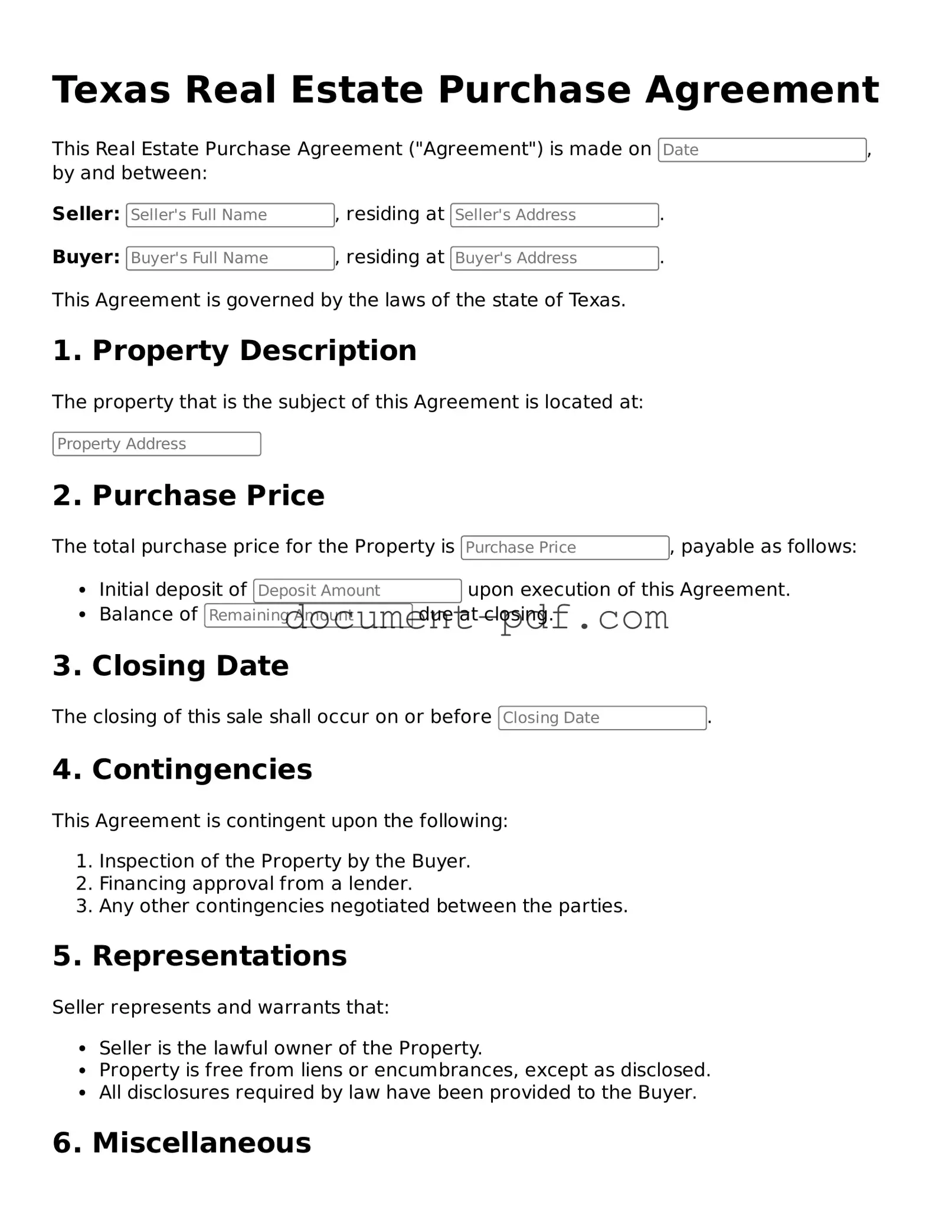The Texas Real Estate Purchase Agreement (REPA) shares similarities with the Residential Purchase Agreement, commonly used in many states. Both documents outline the terms and conditions under which a buyer agrees to purchase a property. They specify details such as the purchase price, closing date, and contingencies. The Residential Purchase Agreement also includes provisions for inspections and disclosures, ensuring both parties understand their rights and obligations throughout the transaction.
Another comparable document is the Commercial Purchase Agreement. While the Texas REPA is tailored for residential transactions, the Commercial Purchase Agreement serves businesses purchasing commercial properties. Both agreements detail the purchase price and conditions, but the Commercial Purchase Agreement may include additional clauses related to zoning laws and business operations. This ensures that the buyer can operate their business without legal hindrances after the purchase.
The Option to Purchase Agreement is another document that aligns closely with the Texas REPA. This agreement grants a potential buyer the exclusive right to purchase a property within a specified timeframe. Like the REPA, it outlines the purchase price and any contingencies. The key difference lies in the Option to Purchase Agreement's focus on securing the buyer’s right to buy rather than finalizing the sale immediately.
The Lease Purchase Agreement also shares similarities with the Texas REPA. This document allows a tenant to lease a property with the option to buy it at a later date. Both agreements cover the purchase price and terms, but the Lease Purchase Agreement includes rental terms and conditions. This arrangement benefits tenants who wish to buy but need time to secure financing or improve their credit.
The Seller Financing Agreement is another document that resembles the Texas REPA. In this scenario, the seller finances the purchase for the buyer rather than a traditional lender. Both agreements outline the purchase price and payment terms, but the Seller Financing Agreement includes details about interest rates and repayment schedules. This option can be appealing for buyers who may struggle to obtain conventional financing.
The Real Estate Listing Agreement is similar in that it involves the sale of a property, but it focuses on the relationship between the seller and the real estate agent. This document outlines the agent's responsibilities, commission rates, and the duration of the listing. While it does not finalize a sale, it sets the stage for the Texas REPA by facilitating the marketing and sale of the property.
The Purchase and Sale Agreement is commonly used in real estate transactions across the U.S. It outlines the terms of the sale, much like the Texas REPA. Both documents cover essential elements such as the purchase price, contingencies, and closing details. However, the Purchase and Sale Agreement may be more general, applicable to various types of properties, while the Texas REPA is specifically designed for Texas residential transactions.
The Real Estate Option Agreement is another document that shares characteristics with the Texas REPA. This agreement provides a buyer with the option to purchase a property at a specified price within a certain timeframe. Both documents outline the purchase terms, but the Real Estate Option Agreement emphasizes the buyer's right to decide whether to proceed with the purchase, adding flexibility to the transaction.
The Joint Venture Agreement can also be compared to the Texas REPA. This document is used when two or more parties collaborate to purchase a property. Similar to the REPA, it includes details about the purchase price and responsibilities of each party. The Joint Venture Agreement focuses more on the partnership aspect, detailing how profits and risks will be shared among the parties involved.
In the realm of property transactions, understanding the documentation involved is essential for ensuring smooth dealings. A crucial aspect is the Bill of Sale, which serves as an official record of ownership transfer. To streamline this process, resources like PDF Templates Online can provide valuable templates that simplify the creation of these important documents.
Finally, the Real Estate Purchase Agreement for Investment Properties is similar to the Texas REPA, but it is tailored for investors. This document includes specific clauses related to property management and rental income potential. Like the Texas REPA, it outlines the purchase price and conditions, but it also addresses the unique needs and considerations of real estate investors, ensuring they have the necessary protections in place.
